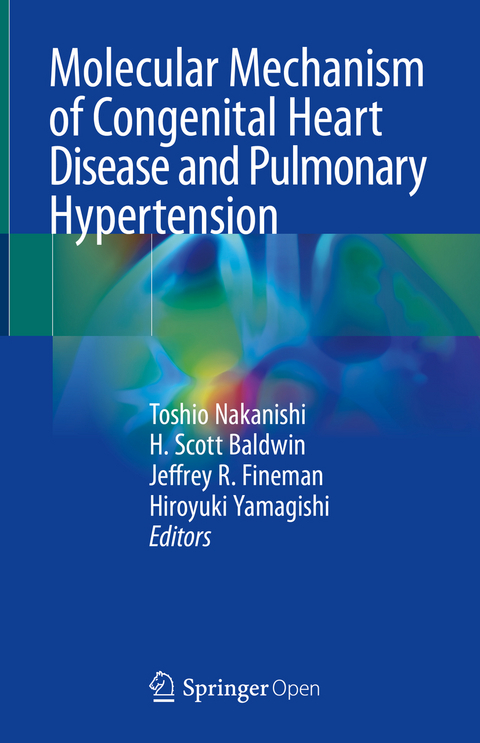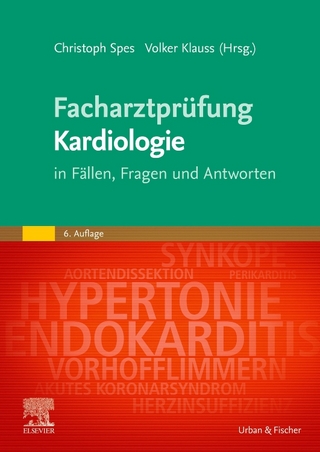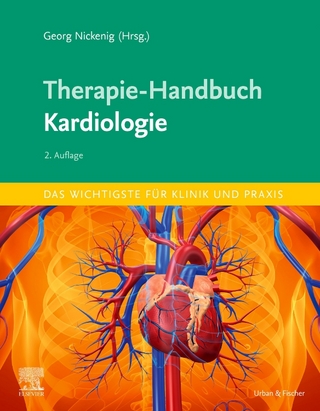
Molecular Mechanism of Congenital Heart Disease and Pulmonary Hypertension
Springer Verlag, Singapore
978-981-15-1184-4 (ISBN)
Toshio Nakanishi Tokyo Women's Medical University Department of Pediatric Cardiology Tokyo, Japan nakanishi.toshio@twmu.ac.jp Scott Baldwin Vanderbilt University Medical Center Department of Pediatrics (Cardiology) and Cell and Development Biology Nashville Tennessee, USA scott.baldwin@Vanderbilt.Edu Jeffrey Fineman University of California UCSF Benioff Children's Hospital San Francisco California, USA Jeff.Fineman@ucsf.edu Hiroyuki Yamagishi Keio University School of Medicine Department of Pediatrics Shinjyuku-ku Tokyo, Japan hyamag@keio.jp
PART I: Basic Science of Pulmonary Development and Pulmonary Arterial Disease.- 1 Perspective for Part I.- 2 The alveolar stem cell niche of the mammalian lung.- 3 Lung development and Notch signalling.- 4 Specialized smooth muscle cell progenitors in pulmonary hypertension.- 5 Diverse Pharmacology of Prostacyclin Mimetics: Implications for Pulmonary Hypertension.- 6 Endothelial-to-mesenchymal transition in pulmonary hypertension.- 7 Extracellular vesicles, MicroRNAs and Pulmonary Hypertension.- 8 Roles of Tbx4 in the lung mesenchyme for airway and vascular development.- 9 A lacZ reporter transgenic mouse line revealing the development of pulmonary artery.- 10 Roles of stem cell antigen-1 in the pulmonary endothelium.- 11 Morphological characterization of pulmonary microvascular disease in bronchopulmonary dysplasia caused by hyperoxia in newborn mice.- 12 Involvement of CXCR4 and stem cells in a rat model of pulmonary arterial hypertension.- 13 Ca2+ signal through inositol trisphosphate receptors for cardiovascular development and pathophysiology of pulmonary arterial hypertension.- PART II: Abnormal pulmonary circulation in the developing lung and heart.- 14 Perspective for Part II.- 15 Pathophysiology of Pulmonary Circulation in Congenital Heart Disease.- 16 Development of Novel Therapies for Pulmonary Hypertension by Clinical Application of Basic Research.- 17 Using Patient-Specific Induced Pluripotent Stem Cells to Understand and Treat Pulmonary Arterial Hypertension.- 18 Modeling pulmonary arterial hypertension using induced pluripotent stem cells.- 19 Dysfunction and restoration of endothelial cell communications in Pulmonary Arterial Hypertension: Therapeutic implications.- 20 Inflammatory Cytokines in the Pathogenesis of Pulmonary Arterial Hypertension.- 21 Genotypes and Phenotypes of Chinese Pediatric Patients with Idiopathic and Heritable Pulmonary Arterial Hypertension- Experiences from A Single Center.- 22 Fundamental Insight into Pulmonary Vascular Disease : Perspectives from Pediatric PAH in Japan.- 23 Risk stratification in paediatric pulmonary arterial hypertension.- 24 The Adaptive Right Ventricle in Eisenmenger Syndrome: Potential Therapeutic Targets for Pulmonary Hypertension.- 25 Impaired right coronary vasodilator function in pulmonary hypertensive rat assessed by in vivo synchrotron microangiography.- 26 Relationship between mutations in ENG and ALK1 gene and the affected organs in hereditary hemorrhagic telangiectasia.- 27 A genetic analysis for patients with pulmonary arterial hypertension.- 28 Evaluation and visualization of right ventricle using three dimensional echocardiography.- 29 Pulmonary hypertension associated with post-operative Tetralogy of Fallot.- 30 Microscopic Lung Airway Abnormality and Pulmonary Vascular Disease Associated with Congenital Systemic to Pulmonary Shunt.- 31 Respiratory syncytial virus infection in infants with heart and lung diseases.- PART III: Ductus arteriosus: bridge overtroubled vessels.- 32 Perspective for Part III.- 33 The ductus arteriosus, a vascular outsider, in relation to the pulmonary circulation.- 34 Molecular, genetic, and pharmacological modulation of the ductus arteriosus: KATP channels as novel drug targets.- 35 New mediators in the biology of the ductus arteriosus: Lessons from the chicken embryo.- 36 Constriction of the Ductus Arteriosus with KATP Channel Inhibitors.- 37 New insights on how to treat patent ductus arteriosus.- 38 Antenatal Administration of Betamethasone Contributes to Intimal thickening of the Ductus Arteriosus.- 39 Prostaglandin E-EP4-mediated fibulin-1 up-regulation plays a role in intimal thickening of the ductus arteriosus.- 40 Transcriptional profiles in the chicken ductus arteriosus during hatching.- 41 Inhibition of Cyclooxygenase Contracts Chicken Ductus Arteriosus.- 42 Prostaglandin E2 receptor EP4 inhibition constricts the rat ductus arteriosus.- 43 Dilatation of the Ductus Arteriosusby Diazoxide in Fetal and Neonatal Rats.- 44 The Effect of Long-term Administration of Plostaglandin E1 on Morphological Changes in Ductus Arteriosus.- 45 Significance of SGK1 as a protein kinase transcriptionally regulated by ALK1 signaling in vascular endothelial cells.- 46 Fabrication of Implantable Human Arterial Graft by Periodic Hydrostatic Pressure.- 47 Optimum preparation of Candida albicans cell wall extra (CAWE) for the mouse model of Kawasaki disease.- PART IV: Development and Regeneration of the Cardiovascular System.- 48 Perspective for Part IV.- 49 Advances in the second heart field.- 50 Novel cardiac progenitors for all components of the heart except for the right ventricle.- 51 Regional and TBX5-dependent gene expression in the atria: Implications for pulmonary vein development and atrial fibrillation.- 52 The Endocardium as a Master Regulator of Ventricular Trabeculation.- 53 The Role of Alternative mRNA Splicing in Heart Development.- 54 Progress in the Generation of Multiple Lineage Human-iPSC-derived 3D Engineered Cardiac Tissues for Cardiac Repair.- 55 Quantification of contractility in stem cell derived cardiomyocytes.- 56 A neurotrophic factor receptor GFRA2, a specific surface antigen for cardiac progenitor cells, regulates the process of myocardial compaction.- 57 Cardiac cell specification and differentiation by the defined factors.- 58 A Temporo-Spatial Regulation of Sema3c is Essential for Interaction of Progenitor Cells during Cardiac Outflow Tract Development.- 59 Spatiotemporally restricted developmental alterations in the anterior and secondary heart fields cause distinct conotruncal heart defects.- 60 Significance of transcription factors in the mechanisms of great artery malformations.- 61 The different c-kit expression in human induced pluripotent stem (iPS) cells between with feeder cells and without feeder cells.- 62 Establishment of induced pluripotent stem cells from immortalized B cell lines and their differentiation into cardiomyocytes.- 63 Establishment of an in vitro LQT3 model, using induced pluripotent stem cells from LQT3 patient-derived cardiomyocytes.- 64 Genetic Assessments for clinical courses of Left ventricle noncompaction.- 65 Elucidating the pathogenesis of congenital heart disease in the era of next-generation sequencing.
| Erscheinungsdatum | 13.03.2020 |
|---|---|
| Zusatzinfo | 74 Illustrations, color; 14 Illustrations, black and white; XIII, 405 p. 88 illus., 74 illus. in color. |
| Verlagsort | Singapore |
| Sprache | englisch |
| Maße | 155 x 235 mm |
| Themenwelt | Medizinische Fachgebiete ► Innere Medizin ► Kardiologie / Angiologie |
| Medizin / Pharmazie ► Medizinische Fachgebiete ► Pädiatrie | |
| ISBN-10 | 981-15-1184-5 / 9811511845 |
| ISBN-13 | 978-981-15-1184-4 / 9789811511844 |
| Zustand | Neuware |
| Haben Sie eine Frage zum Produkt? |
aus dem Bereich


